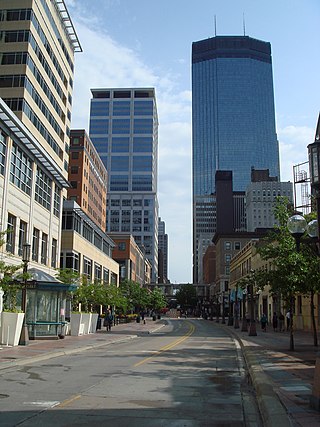
Nicollet Mall is a twelve-block portion of Nicollet Avenue running through downtown Minneapolis, Minnesota, United States. It is the shopping and dining district of the city, and also a pedestrian mall and transit mall. Along with Hennepin Avenue to the west, Nicollet Mall forms the cultural and commercial center of Minneapolis.

The Central neighborhood of Minneapolis, Minnesota, United States is located south of the downtown region of the city. It is bounded by Lake Street on the north, Chicago Avenue on the east, 38th Street on the south, and Interstate 35W on the west. It should not be confused with the Central community, which covers Downtown and some surrounding neighborhoods.

Whittier is a neighborhood within the Powderhorn community in the U.S. city of Minneapolis, Minnesota, bounded by Franklin Avenue on the north, Interstate 35W on the east, Lake Street on the south, and Lyndale Avenue on the west. It is known for its many diverse restaurants, coffee shops and Asian markets, especially along Nicollet Avenue. The neighborhood is home to the Minneapolis Institute of Art, the Minneapolis College of Art and Design, and the Children's Theatre Company.

The U.S. city of Minneapolis is officially defined by the Minneapolis City Council as divided into eleven communities, each containing multiple official neighborhoods. Informally, there are city areas with colloquial labels. Residents may also group themselves by their city street suffixes, North, Northeast, South, Southeast, and Southwest.

The Powderhorn Park neighborhood of Minneapolis, Minnesota, United States is located approximately three miles south of downtown and is bordered by East Lake Street to the north, Cedar Avenue to the east, East 38th Street to the south, and Chicago Avenue to the west. Its namesake is the city's Powderhorn Park facility in the northwestern part of the neighborhood around Powderhorn Lake, which contains playing fields, playgrounds and a park building that hosts community education classes ranging from pottery to yoga. In winter, the Minneapolis Park and Recreation Board sets up a portable warming house and the lake is used for ice skating.

Lowry Hill East is a neighborhood in southwest Minneapolis, Minnesota, United States, part of the Calhoun Isles community. Lowry Hill East developed in the 1880s along a horse-drawn streetcar line built by Thomas Lowry. The interior of the neighborhood is residential, with large early 20th century homes and multi-unit apartment buildings, while the border streets are lined with bars, restaurants, grocery stores, coffeeshops, and other small businesses. Most housing is renter-occupied.
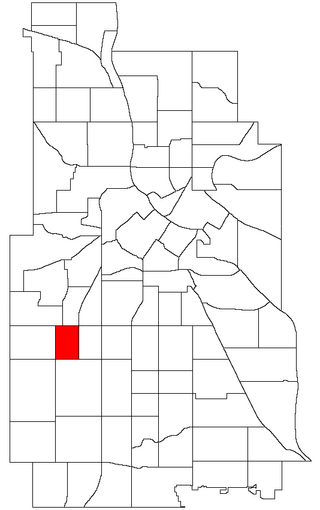
East Bde Maka Ska is a neighborhood within the Calhoun-Isles community in the U.S. city of Minneapolis. It was formerly known as East Calhoun prior to August 2021. The neighborhood is located south of the East Isles neighborhood and its northern portion along with parts of the East Isles, Lowry Hill East, and South Uptown neighborhoods forms the city's Uptown district. East Bde Maka Ska is bordered on the north by Lake Street, on the east by Hennepin Avenue, on the south by West 36th Street and on the west by Bde Maka Ska.

Lake Street is a major east-west thoroughfare between 29th and 31st streets in Minneapolis, Minnesota United States. From its western most end at the city's limits, Lake Street reaches the Chain of Lakes, passing over a small channel linking Bde Maka Ska and Lake of the Isles, and at its eastern most end it reaches the Mississippi River. In May 2020, the Lake Street corridor suffered extensive damage during local unrest over the murder of George Floyd. In August of the same year, city officials designated East Lake Street as one of seven cultural districts to promote racial equity, preserve cultural identity, and promote economic growth.
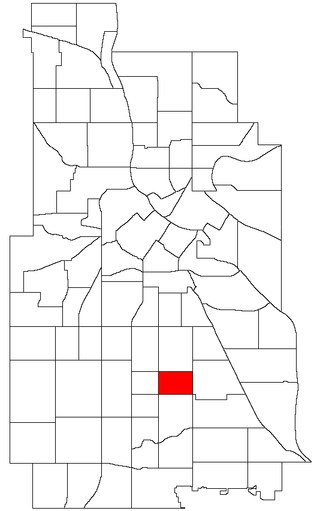
Bancroft is a neighborhood within the Powderhorn community in Minneapolis, Minnesota, United States. Its boundaries are East 38th Street to the north, Chicago Avenue to the west, East 42nd Street to the south and Cedar Avenue to the east.
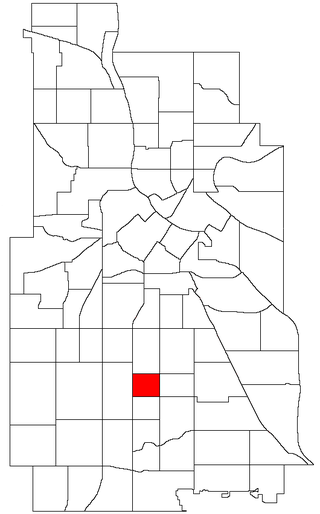
Bryant is a neighborhood within the Powderhorn community in Minneapolis, Minnesota, United States. Its boundaries are East 38th Street to the north, Chicago Avenue to the east, East 42nd Street to the south, and Interstate 35W to the west.

Robert Lilligren is an American politician and member of the Minnesota Democratic-Farmer-Labor Party. He was an elected member of the Minneapolis City Council. He was first elected in 2001, to represent the 8th Ward of the Minneapolis City Council. Following the defeat of Green Party member Dean Zimmermann, during the 2005 municipal elections, Lilligren represented the 6th Ward of the City of Minneapolis. When first elected to office, Lilligren was serving as a volunteer on eight different community boards and commissions including: vice-chair of Phillips West Neighborhood organization, the Midtown Greenway Coalition, the Hennepin County-appointed I-35W Project Advisory Committee, and as a board member for several affordable housing groups throughout South Minneapolis. He lost his re-election bid in 2013 to Abdi Warsame. He was appointed to the Metropolitan Council by Governor Tim Walz in March 2019.

King Field is a neighborhood in the Southwest community in Minneapolis, Minnesota. Its boundaries are 36th Street to the north, Interstate 35W to the east, 46th Street to the south, and Lyndale Avenue to the west. King Field, within the King Field neighborhood is a park named after Martin Luther King Jr.

Powderhorn is a community in Minneapolis, which consists of eight different neighborhoods.
The George Floyd protests in Chicago were a series of civil disturbances in 2020 in the city of Chicago, Illinois. Unrest in the city began as a response to the murder of George Floyd in police custody in Minneapolis on May 25, 2020. The demonstrations and riots, supporting justice for Floyd and protesting police brutality, occurred simultaneously with those of over 100 other cities in the United States. Chicago is among 12 major cities that declared curfews in order to prevent looting and vandalism. On May 31, Mayor Lori Lightfoot asked Illinois Governor J.B. Pritzker to send the Illinois National Guard to Chicago for the first time in the 52 years since the 1968 riots in Chicago. The economic damage caused by the disturbances exceeded $125 million.

Local protests over the murder of George Floyd began on May 26, 2020, and within a few days had inspired a global protest movement against police brutality and racial inequality. The initial events were a reaction to a video filmed the day before and circulated widely in the media of police officer Derek Chauvin kneeling on Floyd's neck for 9 minutes and 29 seconds while Floyd struggled to breathe, begged for help, lost consciousness, and died. Public outrage over the content of the video gave way to widespread civil disorder in Minneapolis, Saint Paul, and other cities in the Minneapolis–Saint Paul metropolitan area in the five-day period of May 26 to 30 after Floyd's murder.

False rumors of a police shooting resulted in rioting, arson, and looting in the U.S. city of Minneapolis from August 26–28, 2020. The events began as a reaction to the suicide of Eddie Sole Jr., a 38-year old black man who was being pursued by Minneapolis police officers for his alleged involvement in a homicide. At approximately 2 p.m. on August 26, Sole died after he shot himself in the head as officers approached to arrest him. False rumors quickly spread on social media that Minneapolis police officers had fatally shot Sole. To quell unrest, Minneapolis police released closed-circuit television surveillance footage that captured Sole's suicide, which was later confirmed by a Hennepin County Medical Examiner's autopsy report.

The George Floyd Square occupied protest is centered at the intersection of East 38th Street and Chicago Avenue in Minneapolis, Minnesota, United States and features several makeshift memorials and street art. The street intersection is where Derek Chauvin, a White police officer with the Minneapolis Police Department, murdered George Floyd, an unarmed 46-year-old Black man, on May 25, 2020. The day after Floyd's murder, people began leaving memorials to him. The street intersection soon transitioned to a controversial occupation protest by people who had erected barricades to block vehicular traffic and transformed the space with amenities, social services, and public art of Floyd and that of other racial justice themes. The unofficial memorial and occupied protest zone was referred to as “autonomous”, "no-go", and "police-free", but local officials disputed such characterizations.

The U.S. city of Minneapolis featured officially and unofficially designated camp sites in city parks for people experiencing homelessness that operated from June 10, 2020, to January 7, 2021. The emergence of encampments on public property in Minneapolis was the result of pervasive homelessness, mitigations measures related to the COVID-19 pandemic in Minnesota, local unrest after the murder of George Floyd, and local policies that permitted encampments. At its peak in the summer of 2020, there were thousands of people camping at dozens of park sites across the city. Many of the encampment residents came from outside of Minneapolis to live in the parks. By the end of the permit experiment, four people had died in the city's park encampments, including the city's first homicide victim of 2021, who was stabbed to death inside a tent at Minnehaha Park on January 3, 2021.
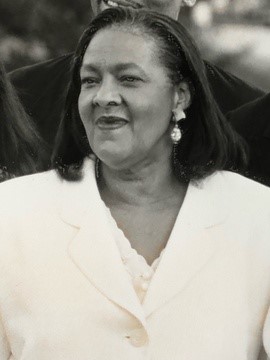
Clarissa Rogers Walker was an American social activist and community leader based in Minneapolis, Minnesota. She was known for her social contributions in the South Minneapolis area for the African-American community. She served for more than three decades as the director of Sabathani Community Center, a multi-ethnicity community service center in Minneapolis, Minnesota. In November 2019, the City Council of Minneapolis announced a commemorative honor to Walker along with activist Launa Newman by renaming and dedicating specific portions of avenues amongst the 38th Street corridor to their names respectively as a tribute to their contributions.

George Floyd Square, officially George Perry Floyd Square, is the commemorative street name for the section of Chicago Avenue in the U.S. city of Minneapolis from East 37th Street to East 39th Street. It is named after George Floyd, a Black man who was murdered there by Minneapolis police officer Derek Chauvin on May 25, 2020. The streetway and memorial site is centered at the 38th and Chicago intersection.






















